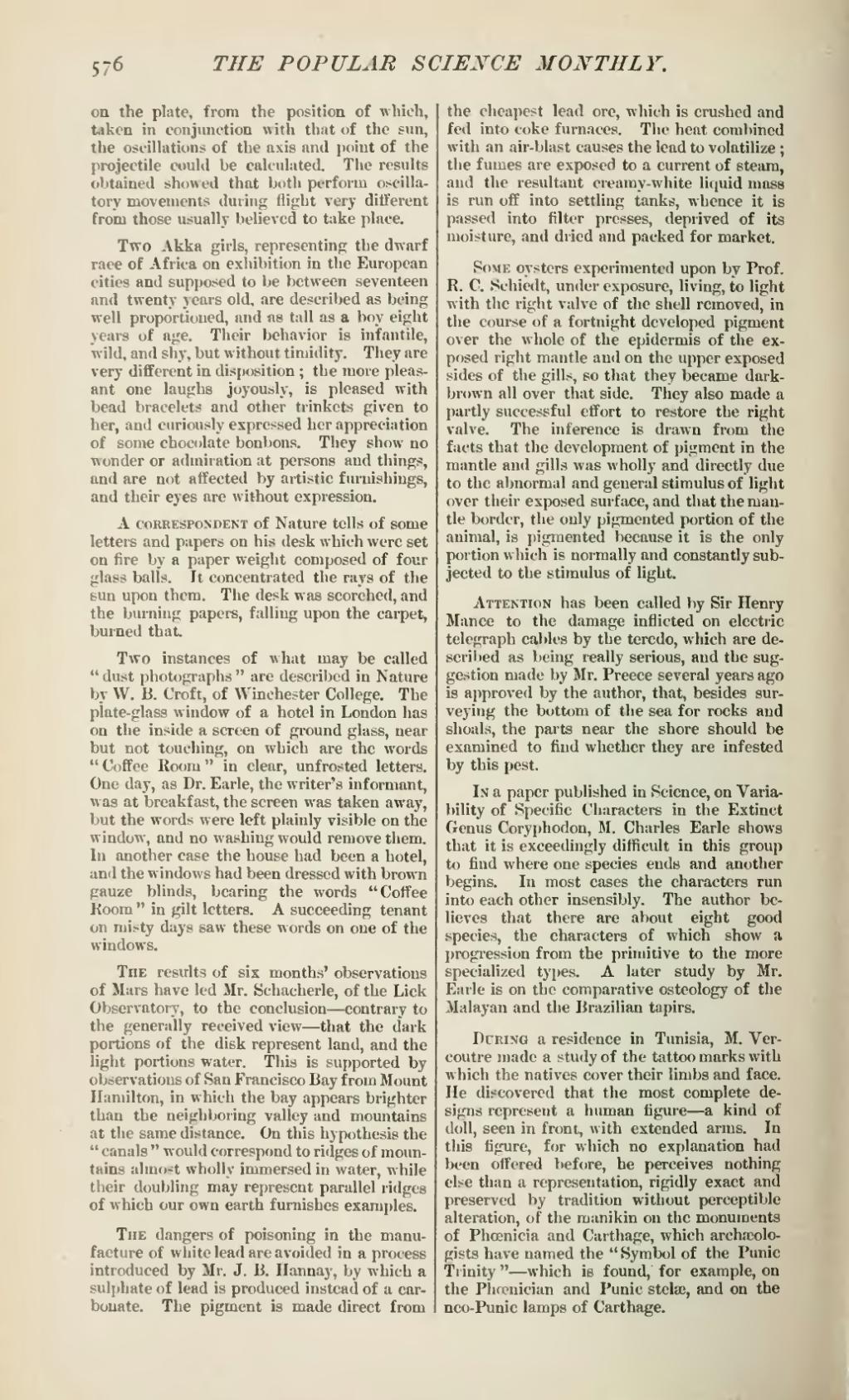on the plate, from the position of which, taken in conjunction with that of the sun, the oscillations of the axis and point of the projectile could be calculated. The results obtained showed that both perform oscillatory movements during (light very different from those usually believed to take place.
Two Akka girls, representing the dwarf race of Africa on exhibition in the European cities and supposed to be between seventeen and twenty years old, are described as being well proportioned, and as tall as a boy eight years of age. Their behavior is infantile, wild, and shy, but without timidity. They are very different in disposition; the more pleasant one laughs joyously, is pleased with bead bracelets and other trinkets given to her, and curiously expressed her appreciation of some chocolate bonbons. They show no wonder or admiration at persons and things, and are not affected by artistic furnishings, and their eyes are without expression.
A correspondent of Nature tells of some letters and papers on his desk which were set on fire by a paper weight composed of four glass balls. It concentrated the rays of the sun upon them. The desk was scorched, and the burning papers, falling upon the carpet, burned that.
Two instances of what may be called "dust photographs" are described in Nature by W. M. Croft, of Winchester College. The plate-glass window of a hotel in London has on the inside a screen of ground glass, near but not touching, on which are the words "Coffee Room" in clear, unfrosted letters. One day, as Dr. Earle, the writer's informant, was at breakfast, the screen was taken away, but the words were left plainly visible on the window, and no washing would remove them. In another case the house had been a hotel, and the windows had been dressed with brown gauze blinds, bearing the words "Coffee Room" in gilt letters. A succeeding tenant on misty days saw these words on one of the windows.
The results of six months' observations of Mars have led Mr. Schacherle, of the Lick Observatory, to the conclusion—contrary to the generally received view—that the dark portions of the disk represent land, and the light portions water. This is supported by observations of San Francisco Bay from Mount Hamilton, in which the bay appears brighter than the neighboring valley and mountains at the same distance. On this hypothesis the "canals" would correspond to ridges of mountains almost wholly immersed in water, while their doubling may represent parallel ridges of which our own earth furnishes examples.
The dangers of poisoning in the manufacture of white lead are avoided in a process introduced by Mr. J. B. Hannay, by which a sulphate of lead is produced instead of a carbonate. The pigment is made direct from the cheapest lead ore, which is crushed and fed into coke furnaces. The heat combined with an air-blast causes the lead to volatilize; the fumes are exposed to a current of steam, and the resultant creamy-white liquid mass is run off into settling tanks, whence it is passed into filter presses, deprived of its moisture, and dried and packed for market.
Some oysters experimented upon by Prof. R. C. Schiedt, under exposure, living, to light with the right valve of the shell removed, in the course of a fortnight developed pigment over the whole of the epidermis of the exposed right mantle and on the upper exposed sides of the gills, so that they became dark-brown all over that side. They also made a partly successful effort to restore the right valve. The inference is drawn from the facts that the development of pigment in the mantle and gills was wholly and directly due to the abnormal and general stimulus of light over their exposed surface, and that the mantle border, the only pigmented portion of the animal, is pigmented because it is the only portion which is normally and constantly subjected to the stimulus of light.
Attention has been called by Sir Henry Mance to the damage inflicted on electric telegraph cables by the teredo, which are described as being really serious, and the suggestion made by Mr. Preece several years ago is approved by the author, that, besides surveying the bottom of the sea for rocks and shoals, the parts near the shore should be examined to find whether they arc infested by this pest.
In a paper published in Science, on Variability of Specific Characters in the Extinct Genus Coryphodon, M. Charles Earle shows that it is exceedingly difficult in this group to find where one species ends and another begins. In most cases the characters run into each other insensibly. The author believes that there are about eight good species, the characters of which show a progression from the primitive to the more specialized types. A later study by Mr. Earle is on the comparative osteology of the Malayan and the Brazilian tapirs.
During a residence in Tunisia, M. Vercoutre made a study of the tattoo marks with which the natives cover their limbs and face. He discovered that the most complete designs represent a human figure—a kind of doll, seen in front, with extended arms. In this figure, for which no explanation had been offered before, he perceives nothing else than a representation, rigidly exact and preserved by tradition without perceptible alteration, of the manikin on the monuments of Phœnicia and Carthage, which archæologists have named the "Symbol of the Punic Trinity"—which is found, for example, on the Phœnician and Punic stelæ, and on the neo-Punic lamps of Carthage.
